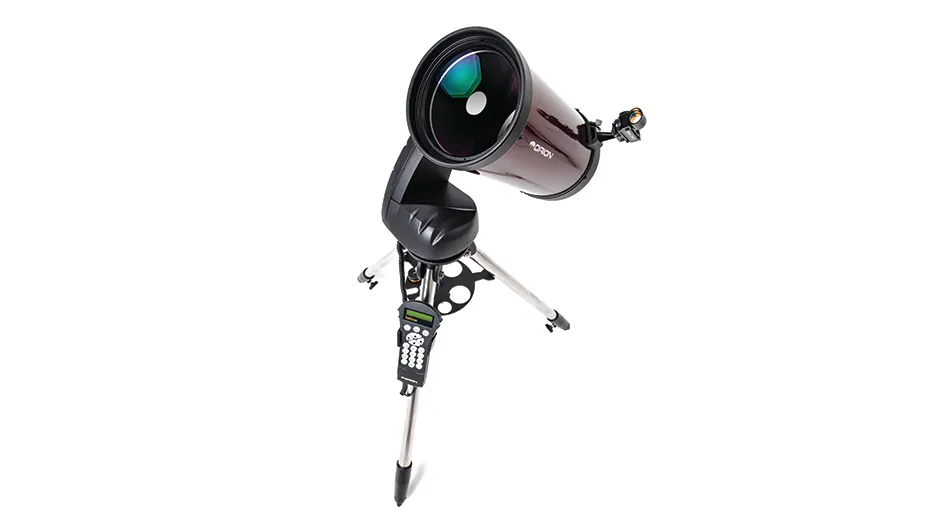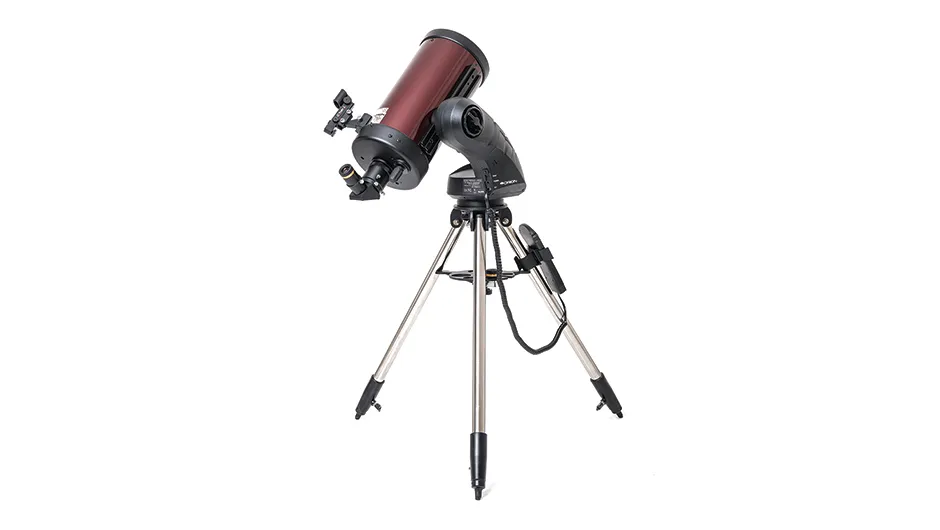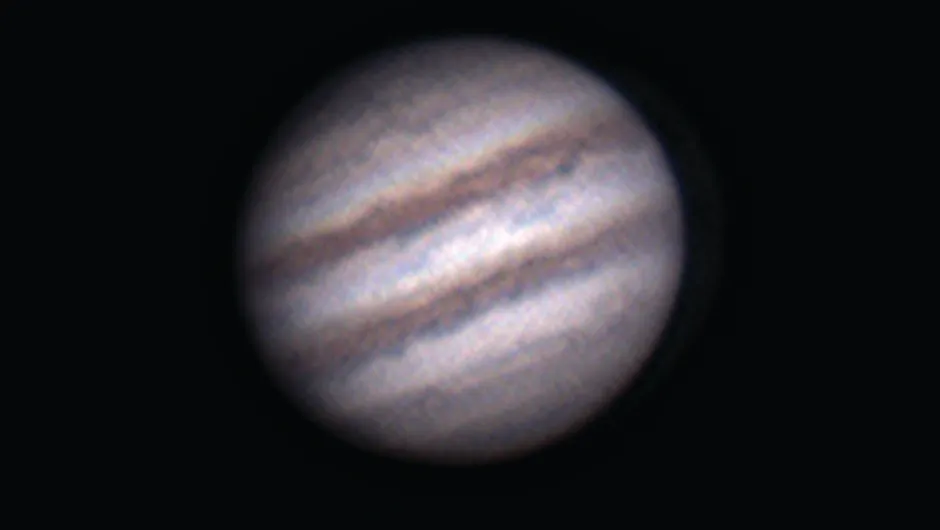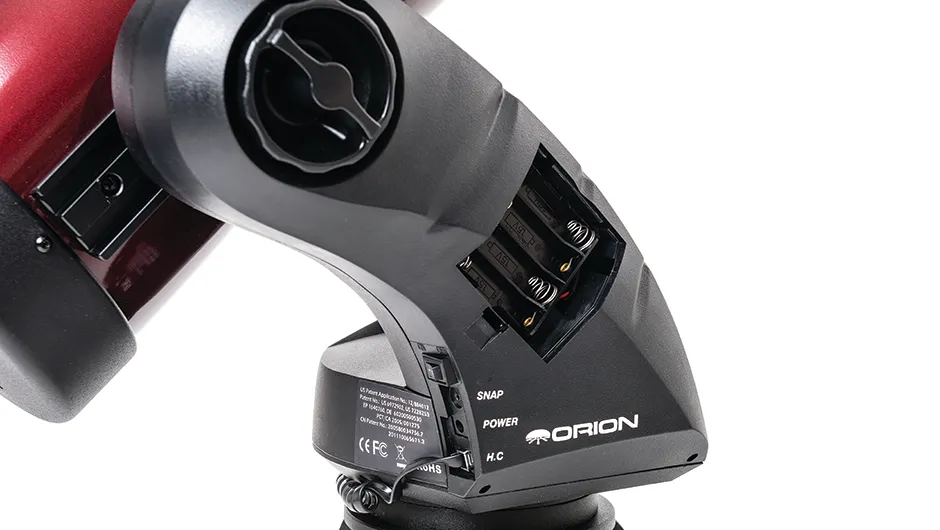Looking smart with its burgundy tube livery, the Orion StarSeeker IV Maksutov-Cassegrain is a complete altaz Go-To system.It consists of a 6-inch telescope and a single-arm computerised Go-To mount with a SynScan V4 handset, mounted on a sturdy stainless steel tripod.
Two 62º apparent field of view eyepieces are included (23mm and 10mm), giving magnifications of 78x and 180x.
A star diagonal, a 2- to 1.25-inch adaptor and an EZ Finder II reflex sight complete the setup.
Assembly was straightforward, with the single arm mount attaching to the tripod head via three bolts and the spreader plate/eyepiece holder strengthening the tripod.
This telescope features in our guide to the best telescopes for observing planets
- Buy now from Orion EU
The telescope attaches to the arm via a built-in Vixen-style bar.
Power is provided by eight AA batteries (there’s an integrated battery compartment in the mount arm) or via a 12V port at the base of the arm.
Once you power up and have entered basic details into the SynScan handset, two alignment options are available: brightest star or two star. Both worked well.
Tracking did wander a little during a 20-minute session with Regulus in Leo, but the star did remain in the field of view of the 23mm eyepiece during this time.
We also used bright Regulus to check the quality of the 23mm eyepiece and were pleased to see a pin-sharp star across most of the field of view, with only slight deterioration towards the edges.
The 23mm eyepiece actually gives a true field of view of 0.79 arcminutes, so just over 0.75º.

Telescope on tour
We used the 23mm eyepiece to take a tour of some of the prime targets in the sky at the time of review, beginning with the Orion Nebula.
With M42 framed in the centre of the view, we could see the wisps and tendrils of nebulosity extending out from the main nebula.
We were able to resolve the central Trapezium Cluster and, swapping to the 10mm eyepiece, were able to see crisp stars with lots of background nebulosity.
The true field of view of the 23mm eyepiece meant that galaxy pair M81 and M82 in Ursa Major only just fitted into the view.
There was plenty of subtle detail in the edge-on M82 and the hazy oval disc of M81 was well seen.
The 78x magnification of the 23mm eyepiece also gave good views of a range of double stars: we were easily able to split Algieba in Leo into its orange and gold components, while Castor took the guise of a lovely pair of white stars of slightly unequal brightness.
Changing to the 10mm eyepiece allowed us to split triple star Iota Cassiopeiae into its three components.
We had few clear periods when the Moon was visible, but the short time we had to look at it revealed plenty of detail to whet the appetite.

We did, however, get to see a great view of Jupiter with its Galilean moons.
The planet was crisp but small in the 23mm eyepiece, but we were able to spot all four Galilean moons in one go.
Cranking up the magnification by swapping to the 10mm eyepiece, we enjoyed subtle detail along the belts, as well as the polar hoods and the Great Red Spot.
Though this setup is primarily intended for visual observing it is possible to use it for limited lunar, planetary and double star astrophotography.
We attached our own CMOS camera, took several short videos of Jupiter and processed them in RegiStax: the resulting image held plenty of detail.
We also recorded videos of double stars Algieba and Castor, and again produced some nice images.

Simple alignment and freedom find
The SynScan V4 handset provides two alignment options, brightest star and two star.
Brightest star means you can choose are area of sky from the menu and it will offer a selection of stars to align on based on the date and time.
Two-star alignment allows you to select any star for the first alignment star.
The alignment options worked well depending on how far apart the initial alignment stars are from each other, with best results with stars separated by around 60º.
However, regardless of which method or distance we used, we always found the target in the field of view of the 23mm eyepiece.
Additionally, encoders on the axis allow you to manually move the mount without losing alignment, something known as ‘freedom find’ technology.
For example, use the handset to find and slew to Jupiter then manually move the mount to view Regulus in Leo.
Press the option for Jupiter again and the mount will slew back to the planet.
Without this feature, if you accidentally moved the mount then you would lose alignment.

Focuser and finder
The focuser was easy to adjust with smooth focusing action and is located at the rear.
The 1.25-inch fit star diagonal and the eyepieces gave good views of a wide variety of subjects, while the EZ Finder II reflex sight was simple to align and use.
SynScan hand controller
The SynScan V4 handset is a little larger than the V3 but has the same button arrangement.
It has a database of 42,900 objects including the Messier, NGC, IC and Caldwell catalogues, planets, named stars, double stars and variable stars.
It also supports user-defined objects.
Single arm fork mount
The single arm fork mount is sturdy and easily attaches to the tripod via three bolts.
Its curved arm allows the telescope tube to aim towards the zenith without catching on the mount’s base, giving you full access to all the sky.
The stainless steel tripod provides good support to the mount and telescope tube.
Ports and power
There are ports for the hand controller cable and an external power tank, as well as a camera ‘snap’ port.
The single arm mount also features a hidden battery compartment for eight AA batteries, so you can power it without a tank.
Optics
The telescope has a focal length of 1,800mm, giving a focal ratio of f/12.
It gave good views, with sharp stars across 85 per cent of the field of view through the supplied 23mm eyepiece and only minor distortion towards the edges.
Vital stats
- Price £827.99
- Aperture 150mm (6 inches)
- FocalLength 1,800mm (f/12)
- Mount Computerised single fork arm altaz
- Weight 12kg
- Supplier Orion Telescopes & Binoculars
- Telephone 0800 8989 0123
- Websitewww.oriontelescopes.co.uk
This review originally appeared in the June 2016 issue of BBC Sky at Night Magazine.

